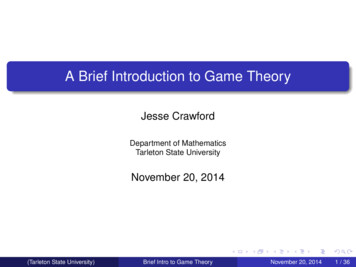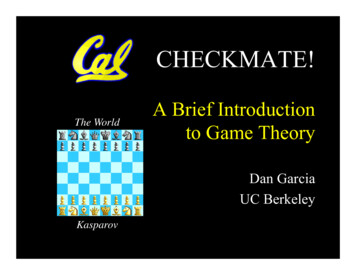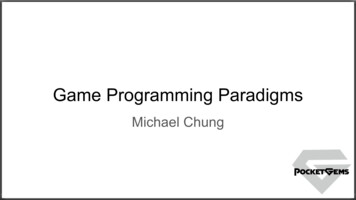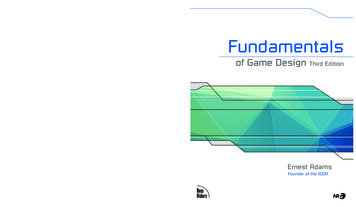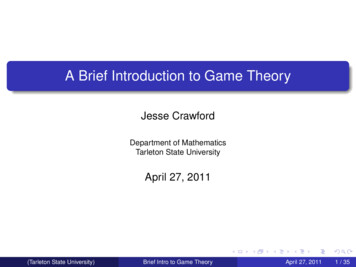
Transcription
A Brief Introduction to Game TheoryJesse CrawfordDepartment of MathematicsTarleton State UniversityApril 27, 2011(Tarleton State University)Brief Intro to Game TheoryApril 27, 20111 / 35
Outline1Games of Perfect Information2Games without Perfect Information3Final Thoughts(Tarleton State University)Brief Intro to Game TheoryApril 27, 20112 / 35
Games of Perfect InformationAll players know all important details of the game state at all times.Games with perfect information:chess, checkers, tic-tac-toeGames without perfect information:poker, rock-paper-scissorsCan be solved using backwards induction.(Tarleton State University)Brief Intro to Game TheoryApril 27, 20113 / 35
Example of a Game with Perfect InformationTwo players.Start with 4 pennies in center of table.Each player can take 1 penny or 2 pennies on his/her turn.Player to take the last penny wins.First player blueSecond player red(Tarleton State University)Brief Intro to Game TheoryApril 27, 20114 / 35
Backwards Induction for Penny Game(Tarleton State University)Brief Intro to Game TheoryApril 27, 20115 / 35
Backwards Induction for Penny Game(Tarleton State University)Brief Intro to Game TheoryApril 27, 20116 / 35
Backwards Induction for Penny Game(Tarleton State University)Brief Intro to Game TheoryApril 27, 20117 / 35
Backwards Induction for Penny Game(Tarleton State University)Brief Intro to Game TheoryApril 27, 20118 / 35
Backwards Induction for Penny Game(Tarleton State University)Brief Intro to Game TheoryApril 27, 20119 / 35
Backwards Induction for Penny Game(Tarleton State University)Brief Intro to Game TheoryApril 27, 201110 / 35
Backwards Induction for Penny Game(Tarleton State University)Brief Intro to Game TheoryApril 27, 201111 / 35
Backwards Induction for Penny Game(Tarleton State University)Brief Intro to Game TheoryApril 27, 201112 / 35
Backwards Induction for Penny Game(Tarleton State University)Brief Intro to Game TheoryApril 27, 201113 / 35
Backwards Induction for Penny GameConclusion: First player wins with optimal play.Backwards induction was easy.Number of variations 5.(Tarleton State University)Brief Intro to Game TheoryApril 27, 201114 / 35
Game Tree for Tic-Tac-Toe(Tarleton State University)Brief Intro to Game TheoryApril 27, 201115 / 35
Tic-Tac-Toe and CheckersWith optimal play, tic-tac-toe is a draw.Schaeffer et al. (2007) showed that checkers is also a draw.http://webdocs.cs.ualberta.ca/ chinook/publications(Tarleton State University)Brief Intro to Game TheoryApril 27, 201116 / 35
ChessNumber of variations is too big to use backwards induction.# of variations 14686 Number of electrons in visible universe!Chess programs do use the game tree.IIOnly plot to finite depth.Use an evaluation function to evaluate s/online-da(Tarleton State University)Brief Intro to Game TheoryApril 27, 201117 / 35
Outline1Games of Perfect Information2Games without Perfect Information3Final Thoughts(Tarleton State University)Brief Intro to Game TheoryApril 27, 201118 / 35
Rock-Paper-ScissorsTwo playersEach one chooses Rock, Paper, or Scissors simultaneously.Rock beats ScissorsScissors beats PaperPaper beats Rock(Tarleton State University)Brief Intro to Game TheoryApril 27, 201119 / 35
Payoff Matrix for RPSFirst player blueSecond player 1)(0,0)(1,-1)Scissors(1,-1)(-1,1)(0,0)RPS is a zero sum game.(Tarleton State University)Brief Intro to Game TheoryApril 27, 201120 / 35
Randomized Strategy for RPSNeed our strategy to be “snoop proof”.Solution: use randomized strategy.IIIpR probability of choosing RockpP probability of choosing PaperpS probability of choosing ScissorsExample:IIIpR 0.7pP 0.2pS 0.1(Tarleton State University)Brief Intro to Game TheoryApril 27, 201121 / 35
Randomized Strategy for RPSExample:IIIpR 0.7pP 0.2pS 0.1If opponent chooses Paper, his expected utility is0.7(1) 0.2(0) 0.1( 1) 0.6This is the maximum utility our opponent can achieve.We want to minimize his maximum utility.(Tarleton State University)Brief Intro to Game TheoryApril 27, 201122 / 35
Minimax Strategy for RPSMinimax strategy:IIIpR pP pS 131313Now if opponent chooses Paper, his expected utility is111(1) (0) ( 1) 0333No matter what he does, his expected utility will be 0.(Tarleton State University)Brief Intro to Game TheoryApril 27, 201123 / 35
Equilibrium StrategiesIn zero sum games with finite strategy spaces, minimax strategiesalways exist for both players.Both players using minimax strategies is an equilibrium:Neither player can benefit from changing strategies.Theory can be generalized to multiplayer games, cf. Nash (1949).(Tarleton State University)Brief Intro to Game TheoryApril 27, 201124 / 35
A Simplified Poker GameBoth players ante 1.Player 1 is dealt a card that says “strong” or “weak”.II50% chance of getting “strong” card.50% chance of getting “weak” card.Player 1 may bet 1 or check.Player 2 may call or fold.If there’s a showdown, Player 1 wins if card is strong and loses ifcard is weak.Player 1 should always bet with strong card.Questions:IIHow often should Player 1 bluff with weak card?How often should Player 2 call when Player 1 bets?(Tarleton State University)Brief Intro to Game TheoryApril 27, 201125 / 35
Expected Value for Player 1p probability that Player 1 bluffs with weak cardq probability that Player 2 calls when Player 1 betsPlayer 1’s expected value isEV1 1 12 [3q 2(1 q)] 12 p[ 1q 2(1 q)]EV1 1 21 [q 2] 12 p[2 3q](Tarleton State University)Brief Intro to Game TheoryApril 27, 201126 / 35
Optimal Calling FrequencyEV1 1 12 [q 2] 12 p[2 3q]Claim: Player 2 should choose q 23 .If q 23 , Player 1 can choose p 1, andEV1 1 q 31 .If q 23 , Player 1 can choose p 0, andEV1 12 q 31 .If q 23 , then(Tarleton State University)EV1 31 .Brief Intro to Game TheoryApril 27, 201127 / 35
A Bit of AlgebraEV1 1 12 [q 2] 12 p[2 3q]EV1 1 21 [q(1 3p) 2 2p](Tarleton State University)Brief Intro to Game TheoryApril 27, 201128 / 35
Optimal Bluffing FrequencyEV1 1 12 [q(1 3p) 2 2p]Claim: Player 1 should choose p 13 .If p 13 , Player 2 can choose q 0, andEV1 p 31 .If p 13 , Player 2 can choose q 1, andEV1 If p 13 , then(Tarleton State University)12 12 p 31 .EV1 13 .Brief Intro to Game TheoryApril 27, 201129 / 35
Simplified Poker Game SolutionPlayer 1 should always bet with a strong card.Player 1 should bluffPlayer 2 should call13 of the time with a weak card.23 of the time when Player 1 bets.Player 1 will win about 33 cents per hand on average.(Tarleton State University)Brief Intro to Game TheoryApril 27, 201130 / 35
Outline1Games of Perfect Information2Games without Perfect Information3Final Thoughts(Tarleton State University)Brief Intro to Game TheoryApril 27, 201131 / 35
A Non-zero-sum Game: Prisoner’s DilemmaTwo criminalsInterrogated in separate roomsStay SilentConfessStay Silent(-1,-1)(0,-10)Confess(-10,0)(-5,-5)General principle: individuals acting in their own self interest canlead to a negative outcome for the group.Related problems:IIIPollution/“Tragedy of the Commons”Cartels/MonopoliesTaxation and public goods(Tarleton State University)Brief Intro to Game TheoryApril 27, 201132 / 35
Areas of Application for Game TheoryEconomics/Political ScienceIBargaining problemsBiologyIIICompetition between organismsSex ratiosGeneticsPhilosophy(Tarleton State University)Brief Intro to Game TheoryApril 27, 201133 / 35
ReferencesChen, B., and Ankenman, J. (2006). The Mathematics of Poker.Conjelco.Luce, R.D., and Raiffa, H. (1989). Games and Decisions:Introduction and Critical Survey. Dover.Nash, J.F. (1949). Equilibrium Points in N-Person Games.Proceedings of the National Academy of Sciences 36 48-49.Schaeffer, et al. (2007). Checkers is Solved. Science 141518-1522.(Tarleton State University)Brief Intro to Game TheoryApril 27, 201134 / 35
Thank You!(Tarleton State University)Brief Intro to Game TheoryApril 27, 201135 / 35
A Brief Introduction to Game Theory Jesse Crawford Department of Mathematics Tarleton State University April 27, 2011 (Tarleton State University) Brief Intro to Game Theory April 27, 2011 1 / 35. Outline 1 Games of Perfect Informa
